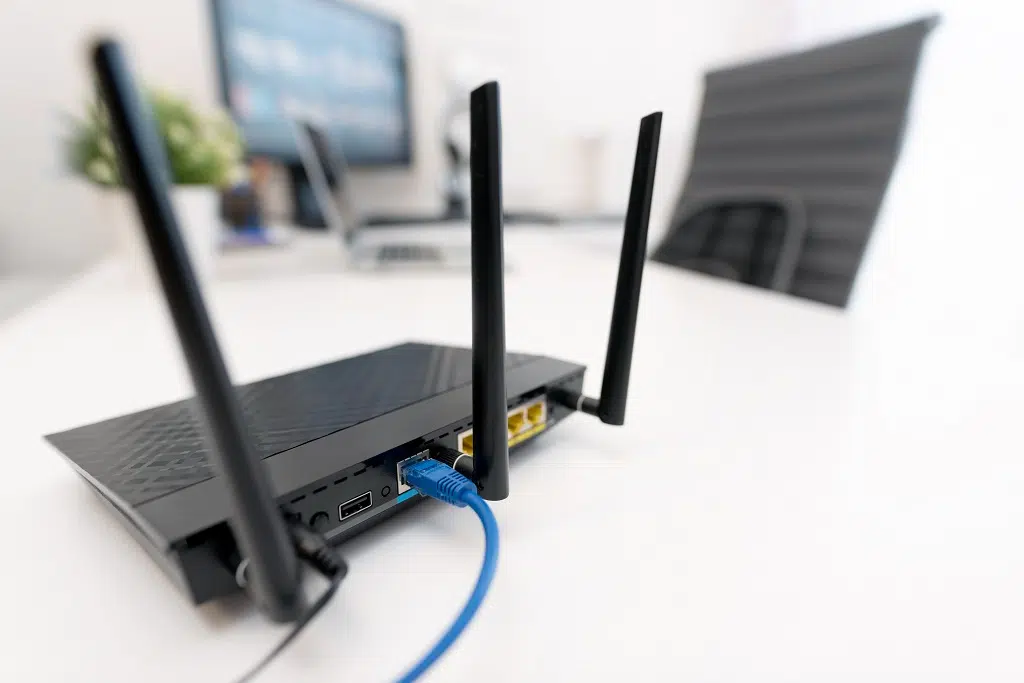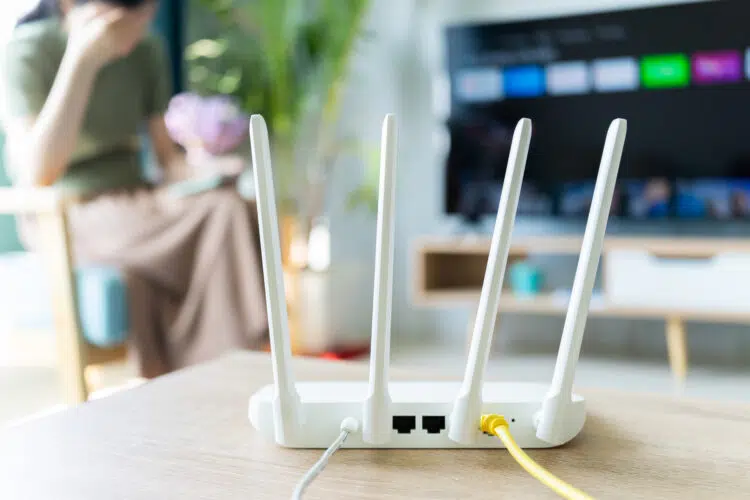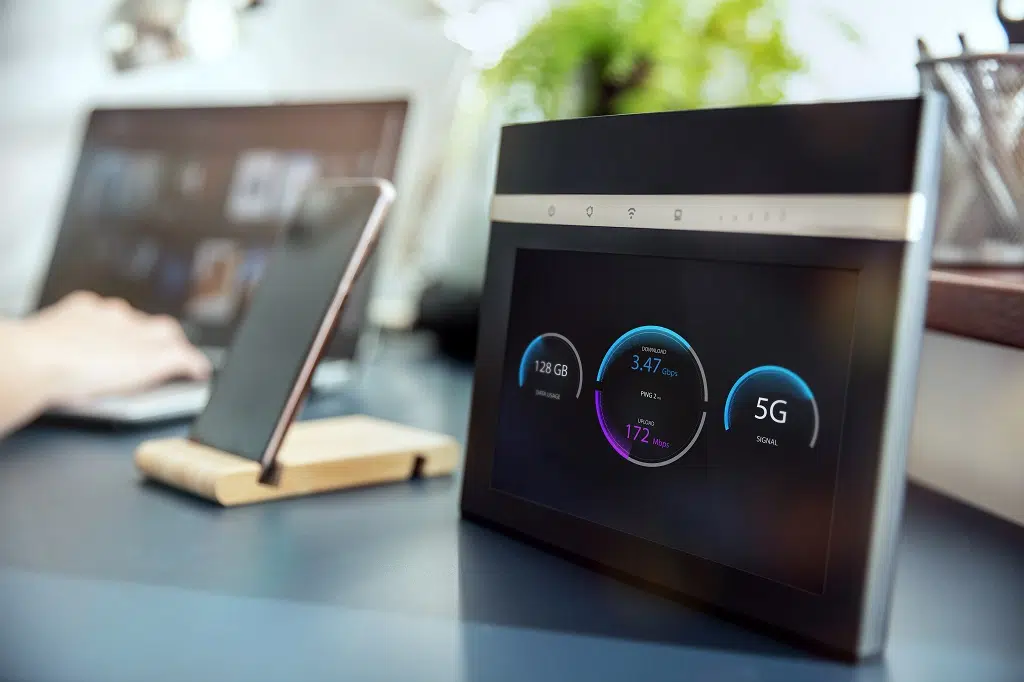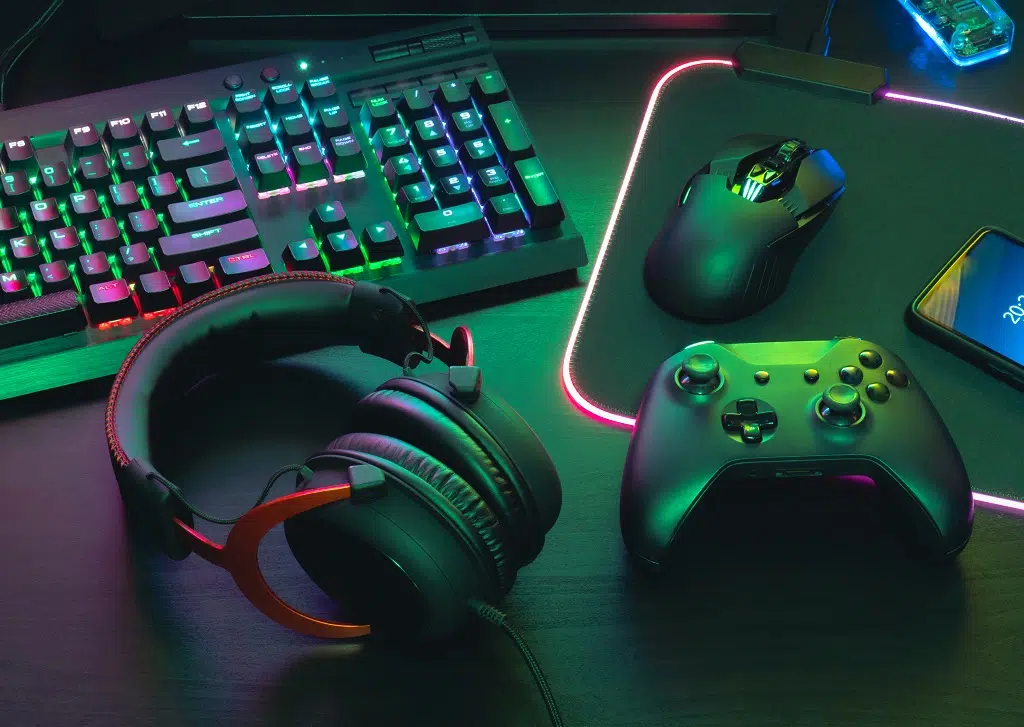Here’s whether a 2.4 GHz or 5 GHz Wi-Fi is better for gaming:
Technically speaking, a 5 GHz connection should be faster in most scenarios.
That said, there are enough variables at play that 2.4 GHz Wi-Fi can be the better choice.
It comes down to connection speeds, interference, and range.
If you want to learn all about whether you should use a 5 GHz or 2.4 GHz Wi-Fi for gaming, then you’re in the place.
Let’s jump right in!
- Gaming on Supercomputer: How?
- Instant Replay Affecting FPS: How?
- Locked FPS: Why So?
- Borderless Windowed vs. Full-Screen: Gaming Performance?
- Games in Real-Time Priority: Safe?
- Games Running on External Drive: Slower or Faster?
- Playing Games off an External Hard Drive or SSD?
- 30 FPS Look Better on Console Than PC: Why?

What Is the Difference Between 2.4 GHz and 5 GHz Wi-Fi? (3 Things)

The first thing to understand is that the numbers 2.4 and 5 refer to bands.
This is a term that describes a frequency range for electronic signaling.
Wi-Fi bands are measured in Gigahertz.
This is a term that measures how frequently the signal vibrates or pulses.
That’s very technical talk, but essentially, 5 GHz Wi-Fi pulses faster than 2.4 GHz Wi-Fi.
Another way to talk about bands is through wavelengths.
If one signal has a higher frequency, it has a shorter wavelength.
This matters a lot when talking about how far a signal can travel and how well it does with physical interference.
We’ll talk more about the specific differences between these bands in the next sections.
Before that, we can explain why frequency and wavelength matter.
If a wireless signal has a higher frequency, that means that devices can pack more information into a single burst from the signal.
This is the principle that makes 5G so much faster than 4G for cellular data.
5G runs at a much higher frequency, so if you do a fast signal burst, it has more bumps in the signal that can be used to express the ones and zeros that the machines use to communicate.
You can almost compare it to font sizes.
If someone types in a smaller font, they can fit more letters on the same page.
That’s how digital communication uses higher frequencies to make connections faster and faster.
As for wavelength, larger wavelengths tend to go farther and penetrate better.
This can get a little weird, but the easiest way to think about it is energy density.
Ultimately, wireless communication uses electromagnetic radiation (which is what light is).
That means that the signals are ultimately carried by individual photons.
Now, every photon has the same amount of energy, but the size of the photon determines how to spread out that energy is.
So, a photon with a very small wavelength has its energy packed into a small, dense region.
Photons can get so small that they can collide with individual electrons (which is how sunburns happen).
With Wi-Fi, the photons have wavelengths measured in inches.
This isn’t super energy-dense, but it’s not the most spread-out signal either.
Some radio transmitters send out photons that are miles long.
Here’s why all of this matters.
For a photon to be stopped, all of the energy has to be absorbed.
So, a 2.4 GHz signal can pass through a wall of sheetrock because the drywall isn’t very dense.
No piece of the wall is the right size to absorb the whole photon, so the photon keeps going.
This is why your Wi-Fi works fine when the router is behind a closed door.
The full explanation of how this works gets deep into quantum mechanics, and it’s very weird.
The short, easy version is that it’s easier for material to absorb a small photon than a big one.
Since wavelengths get smaller as frequencies get higher, faster Wi-Fi tends to not go as far or penetrate through walls and stuff as well.
That got deep into science.
Let’s look at the practical differences between these two Wi-Fi bands.
#1 Speed

A lot of people will tell you that 5 GHz is faster than 2.4 GHz.
After all, 5 is a little more than twice as much as 2.4, and you just read that higher frequencies can hold more information.
You would expect 5 GHz Wi-Fi to be twice as fast, right?
When it comes to theoretical limits, that’s true.
The fastest 5 GHz Wi-Fi available to the public right now hits speeds up to 4.8 Gbps.
Meanwhile, 2.4 GHz Wi-Fi caps out at 1.1 Gbps.
That’s four times as fast!
Here’s the thing.
In practice, the performance difference between the bands will not look like their theoretical limits, and there are a few reasons for that.
The first is internet speeds.
The fastest 2.4 GHz routers can hit speeds of 1.1 Gbps—most residential internet caps at 1 Gbps or slower.
So, 2.4 Wi-Fi can already go faster than your internet connection can handle.
Increasing the theoretical limit on your Wi-Fi won’t make a difference at all.
The other issue at play is signal loss.
All wireless signals are prone to dropping some bits of information here and there.
When that happens, the information has to be requested and sent again.
This is where most of your delays in Wi-Fi occur.
5 GHz signals can carry more information, but they are more prone to dropping data.
When you average it all out, you find that 2.4 GHz and 5 GHz speeds are indistinguishable in most homes.
If we want to be really accurate, the variability of the speeds makes it impossible to tell which one is really playing a game better.
Wi-Fi is complicated, after all.
#2 Range

Let’s talk about range.
Shorter wavelengths go farther and penetrate through walls better.
That makes 2.4 GHz the better Wi-Fi choice, right?
Once again, things get more complicated in practice.
Overall, the 2.4 signal will travel farther and through more stuff.
That’s very reliable.
The thing is that 5 GHz Wi-Fi is standard because it’s good.
Most houses can get great, reliable coverage throughout with only one router.
Your average one-story, a three-bedroom house does fine with a single 5 GHz signal.
It’s kind of like speeds.
If you don’t need larger coverage, then you don’t gain any advantages from switching to 2.4 bands.
That said, houses can get big enough or dense enough that 2.4 starts to noticeably outperform 5 GHz when you aren’t in the same room as the router.
If that’s the case, 2.4 is the obvious choice.
#3 Channels

Here’s where things get even more complicated, and it’s probably the most important difference between the two bands.
In most routers, the 5 GHz band will have more channels than the 2.4 GHz band, and the bands are farther apart.
What does that mean?
Have you ever used walkie-talkies?
If you’re in a crowded place, you might hear other conversations on your walkie.
That happens because you are all on the same channel.
In order to get some privacy, you have to change the radio channel.
This concept applies to Wi-Fi.
Your router will pick a channel for each band.
If you have a bunch of devices on the same channel, then you can get interference.
Each device is trying to have its own conversation with the router, but they are all talking over each other.
In order to fix this problem, the router makes them wait in line before they speak.
That wait time translates to a slower connection speed.
What’s worse is if there is another nearby router on the same channel.
Now, you get crosstalk from devices on a completely different network.
That bogs your system down even farther and makes things even slower.
The solution to all of this is to have as few devices as reasonably possible on a single channel.
So, you want to try to find a Wi-Fi channel that the neighbors aren’t using.
You also want to split your devices between your two bands so that you get less interference.
In that case, both bands will effectively run faster.
What Makes 5 GHz the Better Choice?

Now that we’ve covered how all of this works let’s talk about which one is better.
There are definitely times when the 5 GHz band will give you better gaming performance.
The first is if you have a lot of devices on the router.
The 5 GHz band has more channels, so you can better isolate your channel.
Also, a lot of older and simpler devices don’t use the 5 GHz band at all.
You get less interference just because fewer devices are capable of talking on the 5 GHz band.
This is the primary reason to game on 5 GHz Wi-Fi over a 2 GHz band.
Interference is going to play the biggest role.
It’s also possible that you can make use of the higher theoretical speeds that 5 GHz communication can provide.
If you have an older router, the 2.4 band might not be able to keep up with your internet connection speed.
Older Wi-Fi caps 2.4 communication at 150 Mbps, and a lot of people have faster internet than that.
As long as your gaming device is in the same room as the router, you can see major performance improvements when you choose 5 GHz.
That doesn’t mean that the higher frequency is always the right way to go.
Is 2.4 GHz Ever Better?

There are times when 2.4 will do much better.
In most cases, it’s because you are gaming in a different room than the router.
As you get farther from the router and put more walls between you and the device, you’re going to create more physical interference.
If the 5 GHz connection feels slower than the 2.4 GHz connection, this is most likely why.
Either game in another room or just use the lower frequency for a better connection.
What Is the Best Solution for Gaming?

Here’s the bottom line.
The way to choose the best option is to try them and see what works best.
There are so many things in the world that can affect a network connection that theory and principles won’t get you very far.
Use the one that performs better.
On that note, it’s important to mention one other option. A direct-wired connection is pretty much always going to outperform wireless.
This goes back to signal loss.
Wired connections are just more stable, so they tend to provide a better gaming experience.
Whenever it’s a viable option, you’re going to find it does better.

